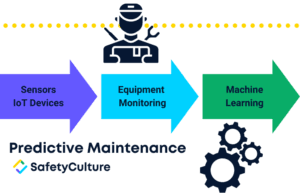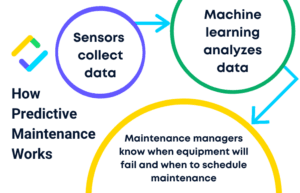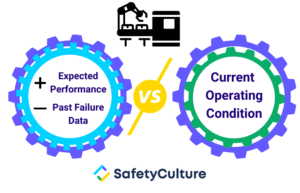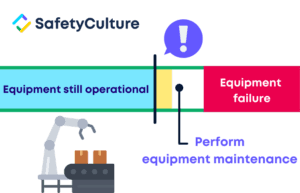What is Predictive Maintenance?
Predictive maintenance is a strategic approach to optimizing equipment usability. Using data collected from IoT devices such as sensors, machine learning, and real-time equipment monitoring, predictive maintenance determines exactly when it’s the best time to perform equipment maintenance. With this capability, maintenance managers save both time and resources.

What is the Difference Between Predictive and Preventive Maintenance?
Preventive maintenance involves doing whatever is required, regardless of the cost or strain on resources, to avoid equipment failure. Predictive maintenance, on the other hand, is focused on taking minimal action while still ensuring that equipment can be used for longer periods of time.
Another difference between predictive and preventive maintenance is that the latter requires frequent inspections, as these form the basis of when maintenance should be performed. With predictive maintenance, equipment conditions can be monitored remotely through the use of sensors and other IoT (Internet of Things) devices (e.g., smart meters, environmental monitoring IoT devices, etc.)
What are Examples of Predictive Maintenance?
Data is at the heart of predictive maintenance. While the following are not straightforward examples of predictive maintenance, they do show how real organizations apply and use data to make more informed decisions and take action where it’s needed.
Example 1: BOS Solutions, a liquid solids separation organization in the oil and gas industry, used its data to predict equipment lifespan. This resulted in less defective or deteriorating equipment being used by workers, which led to a decrease in equipment-related injuries.

Example 2: National Grid UK, a natural gas and electricity transmission company, used their data to spot areas of poor performance, potentially risky areas, and areas of good performance.

By dividing its data into separate categories, the company was able to dive deeper into areas of non-conformance. Within these areas, they identified high-risk issues requiring immediate action. As a result, proactive behavior within the company increased and quality improved.
Predictive Maintenance Benefits
As seen with the examples in the previous section, using data for actions and decisions reaps huge benefits. Given the impact of data on business performance, maintenance managers should consider pursuing predictive maintenance as a proactive maintenance strategy.
While the other types of maintenance, such as preventive, corrective, planned, and condition-based, will not become obsolete in the near future, it’s wise for organizations to get a headstart in applying innovative ideas to their processes.
Below are the top 5 predictive maintenance benefits:
- Streamlined maintenance costs
- Maximized equipment lifespan
- Increased equipment uptime
- Reduced unexpected failures
- Improved equipment reliability
How Does Predictive Maintenance Work?
While applying predictive maintenance leads to concrete results, as stated in the section above, some maintenance managers may find it intimidating or overly complicated. To help clarify how predictive maintenance works, here is a simple outline of the process in 4 steps:
Step 1: Sensors collect real-time data on equipment conditions

Step 2: Data from sensors is processed by a predictive algorithm

Expected performance – For example, after 3 years in operation, equipment should still be producing at a rate of 1.5 units per minute
Past failure data – For example, before equipment failed, it produced only 0.3 units per minute and showed the following deterioration signs
Step 3: Powered by machine learning, the predictive algorithm generates predictions on when equipment will fail

Step 4: Based on these predictions, maintenance managers schedule maintenance to occur right before equipment failure or at the time recommended by the algorithm
How to Get Started with Predictive Maintenance
Though how predictive maintenance works has been explained in general terms in the previous section, maintenance managers may still have difficulty seeing how they can apply a predictive maintenance strategy to their existing maintenance workflow.
This brief guide gives maintenance managers options on how to use predictive maintenance without the technical resources:
-
Choose Equipment to Monitor
While predictive maintenance has many benefits, it cannot be applied to each equipment in operation since it generates large amounts of data from daily equipment monitoring. To conserve organizational resources, maintenance managers must start by only selecting a few pieces of equipment to monitor. The equipment chosen should:
- Have high maintenance costs
- Be prone to equipment failure
- Conditions causing or leading up to failure can be monitored by sensors
-
Choose a Prediction Method
Though using a predictive algorithm is the known prediction method for predictive maintenance, it requires maintenance managers to do either of the following:
a) Develop a predictive algorithm on their own
b) Hire a data scientist to develop a predictive algorithm
c) Purchase specialized software for predictive analyticsThis is why predictive maintenance usually has a high barrier to entry. However, another option available to maintenance managers is to conduct their own predictive analysis.
Depending on the conditions maintenance managers want to monitor and their own preferences, a simple predictive analysis may evaluate a number of variables or factors which will help predict when equipment is most likely to fail.For example, a basic predictive analysis would be taking a certain number of equipment performance issues in a week as a sign that equipment is about to fail.
-
Connect Sensors to Database
If maintenance managers have decided to purchase predictive analytics software, it can also act as a database storing the equipment monitoring data collected by sensors.
For those who have not purchased predictive analytics software, an alternative digital solution is a predictive maintenance tool like SafetyCulture (formerly iAuditor). SafetyCulture can be connected to different types of sensors, such as temperature, humidity, air particulate, gas, and air pressure. -
Connect Sensors to Equipment
Once maintenance managers have connected the sensors to their chosen database, they can proceed with installing sensors to the equipment.
After verifying that sensors are monitoring the correct equipment conditions and sending the data to the database in real-time, maintenance managers should set up alerts that will notify them when equipment conditions have reached a certain point.
-
Schedule Maintenance
When maintenance managers receive alerts from sensors, they can do either of the following:
a) Immediately schedule maintenance or send a maintenance technician on the way
b) For those using a predictive algorithm as their prediction method, they can schedule maintenance at the time recommended by the algorithm
c) For those relying on their own predictive analysis as their prediction method, they can evaluate this information against other factors and then decide when to schedule maintenance
Digitize the way you Work
Empower your team with SafetyCulture to perform checks, train staff, report issues, and automate tasks with our digital platform.
Get Started for Free


